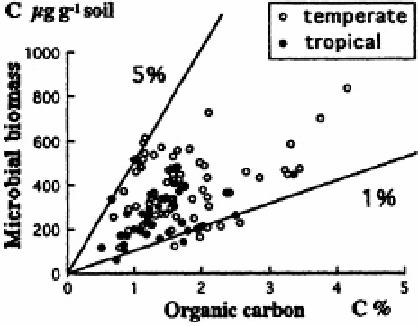Agriculture Reference
In-Depth Information
Microbial biomass, obtained either from direct counts or estimated by the fumigation
technique, has been estimated for a wide range of soils. Values of 300 to 2240 kg dry
weight have been measured in a variety of temperate and tropical soils (Jenkinson
and Ladd, 1981). This usually represents
ca.
1 to 5 % of the total soil carbon and 2 to 6
% of nitrogen (Figure III.3) (Insam; 1990)
Values of up to 8.7 % carbon have been measured by Hasebe
et al.
(1985) in rice paddy
soils of Japan. However, these authors considered that the fumigation technique over-
estimates the biomass since decomposition rate of the non-microbial, easily-
decomposable organic matter is enhanced. Microbial biomass is generally high where
substantial carbon inputs occur. Several authors have observed increased biomasses
where organic fertilisers were added to the soil (see,
e.g.,
Kaczmarek, 1984; Hasebe
et al.,
1985; Schnürer
et al.,
1985).
Microbial biomass is also influenced by soil texture and nutrient content
(e.g.,
Chaussod
et al.,
1986), and by roots and faunal activities (Bakonyi, 1989; Edwards and Bohlen,
1996; Fyles
et al.,
1988; Helal and Sauerbeck, 1986; Holt, 1996 and Chapter IV).
Fungi and bacteria are the main components of the microbial biomass. Their relative
importance varies substantially with organic matter content and such other soil charac-
teristics as texture and pH. In seventeen agricultural and forest soils selected
for their wide range of carbon contents, the relative contributions of bacteria and fungi
to microbial biomass averaged, respectively, 25 % (10-40%) and 75 % (60-90) (Anderson
and Domsch, 1980; Christensen and Funck-Jensen, 1989). Similar proportions have
been indicated by Clark and Paul (1970) in Canadian grasslands. Fungi are usually
dominant in forest ecosystems. Nonetheless, bacteria may represent 78 to 98.2 % of
biomass in paddy soils although organic fertilisation increases the fungal biomass
and thus their relative importance (Hasebe
et al.,
1985). In some cultivated Polish soils,
bacteria represented 72 to 85.6 % of biomass with the lowest values occurring in plots
receiving organic fertilisers (Kaczmarek, 1984).



